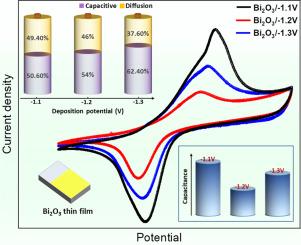Systematic tuning of deposition potential to enhance storage and electrochemical performance of binder-free bismuth oxide (β-Bi2O3) thin film electrodes for supercapacitors
IF 6.3
2区 材料科学
Q2 CHEMISTRY, PHYSICAL
引用次数: 0
Abstract
In this study, we systematically investigated the influence of deposition potential on the structural, morphological, optical, and electrochemical properties of binder-free tetragonal bismuth oxide (β-Bi2O3) thin films electrodeposited onto fluorine-doped tin oxide (FTO)-coated glass substrates. The three prepared films consistently exhibited the stable tetragonal bismuth oxide (β-Bi2O3) phase across all deposition potentials of -1.1 V, -1.2 V, and -1.3 V. However, variations in deposition potential had a pronounced effect on the films’ crystallinity, optical band gap, surface morphology, and supercapacitive behavior. Notably, films deposited at -1.1 V and -1.3 V exhibited higher crystallinity levels of 61 % and 56 %, respectively, compared to 51 % for the film prepared at -1.2 V. The morphology of the bismuth oxide (β-Bi2O3) nanostructures demonstrated a transition from quasi-spherical particles to cauliflower-like nanostructures with increasing potential, which was accompanied by a notable reduction in the optical band gap, decreasing from 2.5 eV at -1.2 V to 2.29 eV at the higher deposition potential of -1.3 V. Electrochemical measurements further emphasized the significant impact of deposition potential on the supercapacitive performance, with the bismuth oxide (β-Bi2O3) film deposited at -1.1 V delivering a superior areal capacitance of 138.5 mF cm-2 (325.3 F g-1). markedly outperforming films deposited at higher potentials. Moreover, charge storage analysis demonstrated a shift in the dominant charge storage mechanism, transitioning from diffusion-controlled behavior at lower potentials to a more pronounced capacitive contribution at higher potentials. Overall, these findings underscore the critical role of deposition potential in tailoring the properties of bismuth oxide (β-Bi2O3) thin films for enhanced supercapacitive performance.

系统调整沉积电位以提高无粘结剂氧化铋(β-Bi2O3)薄膜超级电容器电极的存储和电化学性能
在这项研究中,我们系统地研究了沉积电位对电沉积在氟掺杂氧化锡(FTO)镀膜玻璃衬底上的无粘结剂四方氧化铋(β-Bi2O3)薄膜的结构、形态、光学和电化学性能的影响。制备的三种薄膜在-1.1 V、-1.2 V和-1.3 V的沉积电位下均表现出稳定的四方氧化铋(β-Bi2O3)相。然而,沉积电位的变化对薄膜的结晶度、光学带隙、表面形貌和超电容行为有明显的影响。值得注意的是,在-1.1 V和-1.3 V下沉积的薄膜的结晶度分别为61%和56%,而在-1.2 V下制备的薄膜的结晶度为51%。氧化铋(β-Bi2O3)纳米结构的形貌表现出从准球形颗粒到菜花状纳米结构的转变,并伴有光学带隙的显著减小,从-1.2 V时的2.5 eV减小到-1.3 V时的2.29 eV。电化学测量进一步强调了沉积电位对超级电容性能的显著影响,在-1.1 V下沉积的氧化铋(β-Bi2O3)薄膜提供了138.5 mF cm-2 (325.3 F -1)的优越面电容。明显优于在高电位下沉积的薄膜。此外,电荷存储分析表明,主要的电荷存储机制发生了转变,从低电位下的扩散控制行为转变为高电位下更明显的电容性贡献。总的来说,这些发现强调了沉积电位在调整氧化铋(β-Bi2O3)薄膜性能以增强超级电容性能方面的关键作用。
本文章由计算机程序翻译,如有差异,请以英文原文为准。
求助全文
约1分钟内获得全文
求助全文
来源期刊

Surfaces and Interfaces
Chemistry-General Chemistry
CiteScore
8.50
自引率
6.50%
发文量
753
审稿时长
35 days
期刊介绍:
The aim of the journal is to provide a respectful outlet for ''sound science'' papers in all research areas on surfaces and interfaces. We define sound science papers as papers that describe new and well-executed research, but that do not necessarily provide brand new insights or are merely a description of research results.
Surfaces and Interfaces publishes research papers in all fields of surface science which may not always find the right home on first submission to our Elsevier sister journals (Applied Surface, Surface and Coatings Technology, Thin Solid Films)
 求助内容:
求助内容: 应助结果提醒方式:
应助结果提醒方式:


